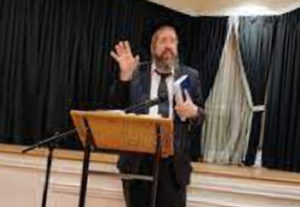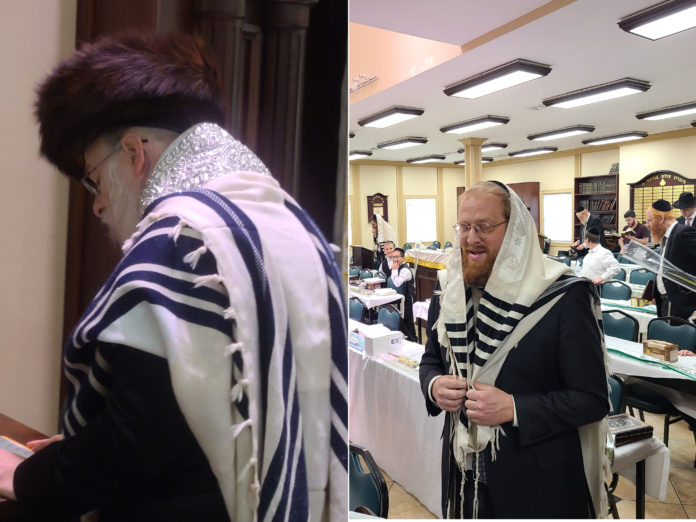By Rabbi Yair Hoffman for 5TJT.com
Join our WhatsApp groupSubscribe to our Daily Roundup Email
This past Shabbos Chol haMoed, Rav Mottel Dick Shlita, a leading and well-respected Rosh Yeshiva now in Monsey and formerly in Staten Island, delivered a remarkable shiur at Kollel Avreichim of Far Rockaway/Five Towns. The Kollel, led by Rav Leibel Rand Shlita (pictured left), has created a profound impact on the community. It’s Kollel members are among the leading Torah scholars in the country, and its graduates have created Torah institutions throughout the community, including one of the top mesivtas in the New York metropolitan area, Mesivta Shaarei Chaim, as well as a Beis Midrash in Far Rockaway that has attracted bochurim from as far as Lakewood, New Jersey and Monsey New York. Rav Dick shlita is the son-in-law of Rav Elya Svei zt”l. He was in Far Rockaway for the Shalom Zachar of an einekel and graced the Kollel with his presence.

[WARNING: Please be advised that this is only my understanding of Rav Dick’s presentation – after a Hoshana Rabbah night review of it. It could be that I may be missing something significant or misunderstood his intent.]
Rav Dick shlita spoke about a very famous and enigmatic Rashi on the first Mishna in Sukkah. Rashi writes that the reason why a Sukkah that has more sun than shade is invalid is because the minority section of the Schach is negated by the majority section of the Schach and it is considered as if it is nonexistent. Rav Dick presented the question that a number of meforshim pose:
Why was it necessary for Rashi to explain this very lengthy exposition? Why didn’t Rashi merely state that a Sukkah is defined by having Schach on it and we need that the Schach be more shade than sun – otherwise there is no Sukkah? (This question is posed by the Steipler, Rav Chaim Kanievsky’s father, as well.)
PLEASE HELP A VERY CHOSHUV HACHNASSAS KALLAH SITUATION
https://thechesedfund.com/zechornilah/hachnasaskallah
Rav Dick presented a few answers that were proposed by the Acharonim. One answer is that Rashi is explaining why one cannot simply say Rubo kekulo if it is a din in the schach.
Rav Dick further asked, “How can there be a taaruvos here, a mixture with a minority and a majority – it is nikar – recognizable. We do not say that a Rov beats a mi’ut when the minority part is recognizable.
ANALYZING DIFFERENT TYPES OF MAJORITY OF SHADE
Rav Dick delved into the different possible situations of a majority of shade over sun. It is possible, for example, for one section of the Sukkah to have a majority of shade over sun, say, 5 parts of it shade and 3 parts of sun and the second section having 4 parts sun and 3 parts shade. If we total them, the shade has 8 parts and the sun has 7 parts – leaving us with a majority of sun. Would such a Sukkah be valid or invalid?
THE BRAISAH ON 19B
Rav Dick pointed out that later in the Gemorah on Sukkah 19b, there is a braisah to which four explanations are provided. This Gemorah has perhaps not been sufficiently explored by the commentaries to shed light on our enigmatic Rashi.
Rav Dick explains that the simple understanding of majority of shade over sun must be that the shade must be greater than the sun in every part of the Sukkah. There cannot be a section at all where the sunny part could be greater than the shady part. It is only through the explanation of Rami Bar Bar Chamah in the name of Rav Yochanan and the statement of Ullah on it that a Sukkah whose majority comprises more shade than sun would be kosher – valid through the principle of Psal HaYotzeh Min HaSukkah.
READING THE TOSEFTA
The Tosefta tells us psal hayotzeh min hasukkah nidun k’sukkah – Fit roofing that consists of different kinds of agricultural waste products that extend from the sukka has the legal status like that of the sukkah.
READING THAT SECTION OF THE GEMORAH
The Gemara had previously asked: What is the meaning of “Psal HaYotzeh” that extend from the sukka? Ulla said: pasul schach that extends out from the sukkah (i.e. kosher schach) are considered like the sukkah (i.e. like the kosher schach).
Rabba bar bar Ḥana said that Rabbi Yoḥanan said: The Tosefta was needed only to teach us the case of a sukkah where in its majority its shade exceeds its sunlight, and in its minority its sunlight exceeds its shade. We would have thought that since the extension lacks this basic requirement of a sukkah, it is treated as if it were not there at all, and therefore – the whole sukkah would be pasul because of that little area, therefore, Ulla teaches us that the entire area is considered one fit sukkah.
[The Gemara asks: According to that understanding of the Tosefta, what is the meaning of: psal hayotzeh min hasukkah (Waste that extends from the sukkah)? It means that the roofing extends beyond the halakhic parameters for fitness of a sukkah. It does not refer to a physical extension of the sukkah like the earlier explanations did.]
THE DARCHEI MOSHE CITING RABBEINU YERUCHEM
In OC 631:1, the Darchei Moshe writes that if in a smaller section of the Sukkah (say 49% of it) the shade is much much more than the sun and in the larger section of the Sukkah the sunny part is slightly more than the shady part – even though overall in the Sukkah, the shade is greater than the sunny part – the Sukkah would be pasul. The Darchei Moshe writes that this is the indication from the wording of both the Rosh and the Tur.
We see that even at the end of the sugyah after everything is said and done, we judge each part of the Sujjah individually – it is just that with the concept of “Psal HaYotzeh” if the majority of the Sukkah is more shade than sun – it is still valid.
THE RAN’S MACHMIR POSITION
The Ran writes that this whole business of a Sukkah still being kosher when the majority of the Sukkah has more shade than sun even though a minority has more sun than shade could be limited to the case of a small Sukkah. But in a case of a large Sukkah that has a 7 by 7 section where the sunny part is greater than the shady part – there is a tzarich iyun if it would still be considered kosher on account of the rest of the “more shaded” schach.
The Ran’s view is quoted in the Bais Yoseph and the Ramah in 631:2.
THE BACH’S LENIENT POSITION
The Bach, on the other hand, entirely disagrees with the Ran’s idea and writes that for a small Sukkah we would not need the concept of “Psal HaYotzeh” to make it kosher! It would have been kosher even without this concept – [just with a simple Rov].
POST MACHLOKES ANALYSIS
It seems that according to the Ran, a Sukkah is only valid if the Schach is spread across the whole Sukkah in a majority and not bunched up where there is a 7 by 7 section where the sun is more than the shade. A Sukkah where the Schach looks like this [IIIIIIII I I I] would be a problem, but according to the Bach it would be kosher.
According to the Bach, as long as the majority of the Sukkah is more Shade than sun – you can add up the sunnier part of the schach too as long as overall there is more shade than sun. In other words, a bamboo poled schach could still be sparse on one side as long as it is a minority of the whole Sukkah. [IIIIIIII I I I] would still be okay.
BACK TO THE RASHI
It would seem that our enigmatic Rashi is telling us how he learns up the Gemorah later on 19b as well – that in a case where the minority of the Sukkah has less shade than sun, the minority becomes non-existent. The Tanna is telling us, according to Rashi, that the sparsely shaded part cannot be counted in as batel berov – it is rather considered like it is not there.
The din of psal hayotzeh, however, refers to the less than 7 by 7 section – where that area’s schach is considered as if it is majority – shaded – it is batel to the rest of the majority shaded schach and becomes a part of it on account of the 4th reading of the Tosefta.
[It is interesting to note that this is only an issue regarding what part of the schach can be counted, but in regard to whether we can still count the walls as part of the whole Sukkah it would work because because we have a majority of shade – see Rashi 7b].
The author can be reached at [email protected]. With apologies to Rav Dick if there were errors or lacunae in the author’s written version here. Corrections or haaros are welcome.
PLEASE HELP A VERY CHOSHUV HACHNASSAS KALLAH SITUATION

